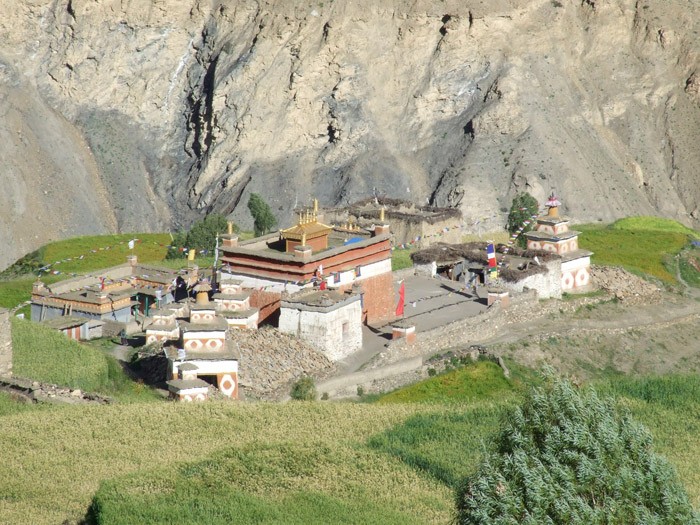The Dolpo region covers 15% of the total area of Nepal and has been arbitrarily divided into a Lower (Outer) and Upper (Inner) region. It is the highest inhabited land in Nepal, hidden behind high passes from the south and lying northwest of Dhaulagiri and the Kali Gandaki gorge. Geographically it is a southern extension of Tibet, within the borders of Nepal: a vast arid region of brown ridges in the rain-shadow of the monsoon. The Shey-Phoksundo National Park is the country’s largest conservation area: opened to trekking in the 1990’s.
The region sustains an abundance of wild life including Himalayan blue sheep, musk deer, jackals, and snow leopards. Birds include Himalayan griffons, snow pigeons and several species of pheasant (including Nepal’s national bird: the impheyan pheasant).
The Dolpopa are a hardy people of Tibetan origin. They are believed to have migrated into this region from about the 6th C. Their language and customs are unique to the region. Their religion still contains ancient shamanistic practices of Bon mysticism, amalgamated with Buddhism. Most monasteries in Dolpo are either Bon or Kagyupa (famous for its scholars Tilopa, Marpa and Milarepa) – although there seems to be a trend to convert to Nyingmapa: the oldest sect founded by Guru Rinpoche. The Do Tarap region has numerous Bon monasteries.
The people have had little contact with the south and have maintained their links with Tibet through trade; exchanging barley for Tibetan rock salt and soda ash (used for cleaning). Yaks are taken onto the Tibetan plateau for summer grazing; although this routine was much disrupted when China officially closed the border after 1959.
The spiritual heart of inner Dolpo is the Shey Gompa. It is situated below Riwo Drugdra, the Crystal Mountain – a grey walled bulk, so called because of the unusual veins of mineral stratification lacing its flanks. It guards the northern entrance to the Ngadra La from Shey.
This 11th century gompa is said to have been constructed by a Tibetan Buddhist teacher who arrived on the back of a flying snow lion. It is widely revered and each July hundreds of Buddhist pilgrims visit the gompa and make a ‘kora' (pilgrim’s circuit) around the ‘Crystal Peak': Dolpo's version of Mount Kailas. The ancient Tsakang (red house) Gompa clings to the side of a red cliff on the far side of the kora trail and is worth a visit, en-route to Shey.
The annual festival lasts for several days and is not only a religious matter. It brings people together from remote villages and regions, and is a time for sharing news, doing business, drinking, dancing and singing. During the rest of the year, the gompa remains locked, but may be visited.
The main building is modest and its assembly hall seems small, its paintings recent, and the artist is unknown. Musical instruments and religious artefacts are present, but do not appear to be in regular use. Extensive mani walls snake around to fit into the complex.
The region was visited in 1973, with special permission, by the scientist George Schaller (Stones of Silence) who was accompanied by Peter Matthiessen (The Snow Leopard) to study rare Himalayan blue sheep and scarce snow leopards. Matthiessen's book describes his trek and his personal spiritual journey and offers a magnificent introduction to this region. Schaller’s account of the journey and his findings is equally fascinating.
The film Caravan, also sold as Himalaya, documents a journey through this region and powerfully illustrates many aspects of the lives of these doughty people.
MMT offers three camping treks to this unique region:
- A 10 days circuit from the air strip at Juphal in Lower Dolpo to visit the beautiful blue waters of Lake Phoksundo, Nepal’s deepest lake, and the culturally diverse region of Do Tarap. This gives an ideal introduction to Dolpo and the Dolpopa. It includes three passes of over 5000m.
- A 26 day Lower Dolpo trek that begins at Beni, in the Kali Gandaki Valley and trails north-westwards, across the southern slopes of the Dhaulagiri Massif, through the Dhorpatan National Park to Tarakot, then into the culturally fascinating Do Tarap region before trekking over two high passes to Lake Phoksundo. This multi-layered trek ends in Juphal for flights back to Kathmandu.
- A 24 day trek to Inner Dolpo. Fly into Juphal and trek to Lake Phoksundo. Then enter the restricted region of Upper Dolpo and trek to Shey Gompa and on to Saldang, the largest village in the region, before turning south to join the Do Tarap route back to Juphal. This demanding trek requires a permit costing US$500 for a week, then a daily rate. It includes eight nights at over 4000m, requiring careful acclimatization and slow ascents of each pass.





